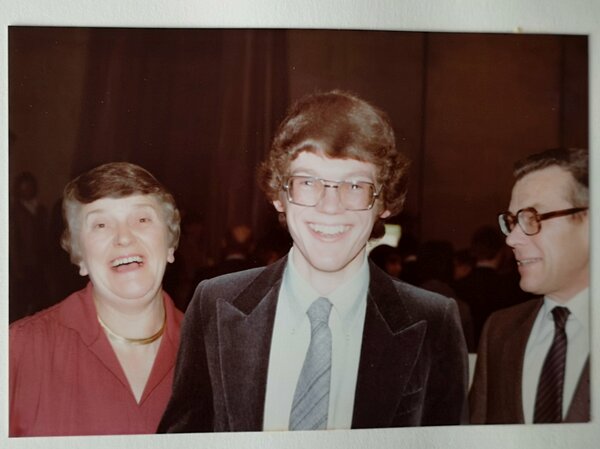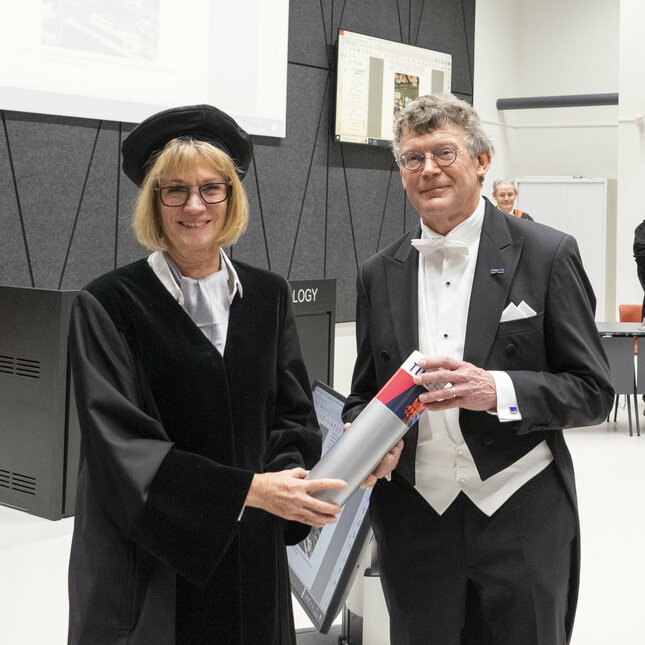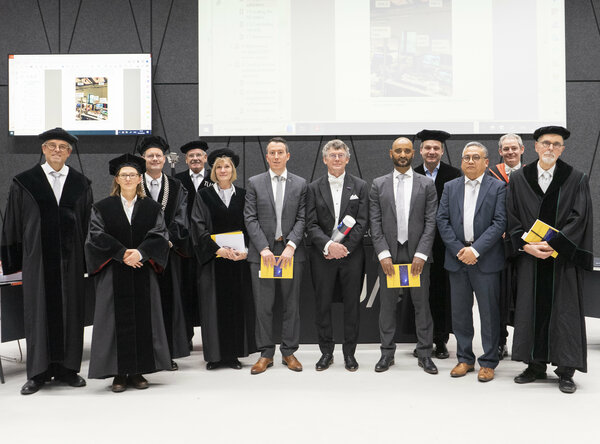Professor Ton Koonen finds the missing PhD link
More than 20 years after joining TU/e as a full professor in electrical engineering, Ton Koonen defended his PhD thesis on December 12th.
![[Translate to English:] [Translate to English:]](https://assets.w3.tue.nl/w/fileadmin/_processed_/f/5/csm_Koonen%20Banner%20image_8b70a34793.jpg)
In the life of retired TU/e professor Ton Koonen, December 2023 is a month of significance. On December 5th, he was the co-promotor for PhD researcher Yu Wang, while on December 19th, he is the co-promotor for Yuchen Song. Sandwiched in between the defenses of Wang and Song though, amazingly Koonen defends his own PhD thesis on wireless optical communications, 44 years after leaving TU/e with a master's degree in electrical engineering. The tale of an incredible academic adventure with an inspiring conclusion.
There’s an unfamiliar commotion on the ground floor of the Atlas building on this early Monday afternoon. Workers are busy assembling TU/e’s Christmas village as 2023 comes to a close.
Sitting across from me as drills hum in the background is Ton Koonen – full professor emeritus at the Department of Electrical Engineering – who has just returned from the coffee corner with a fresh cup of coffee. And he’s ready to answer my questions about an intriguing personal research story.
Before retiring in 2021, Koonen had been vice-dean of the Department of Electrical Engineering (2012 – 2020), as well as being Scientific Director of the Institute for Photonic Integration (2016 – 2019).
The highly-respected researcher has been retired for more than two years, but there was one thing missing from his impressive CV which includes numerous awards and recognitions. And as surprising as it might sound, the one thing missing is a PhD. To address this, Koonen defended his PhD thesis at the Department of Electrical Engineering on December 12th.

‘The Missing Link’
As we settled down for what I know will be an insightful chat, I had one obvious question – “Why do a PhD now?”
“That’s a logical question, and a good question of course,” replies Koonen. “Back in 1979, I completed my master's in electrical engineering at TU/e, at a time when it wasn’t easy to get a job. Interestingly, my professor at the time urged me not to do a PhD and to grab a job while I was young as I already had received three job offers.”
Koonen joined Philips’ Telecommunications Industry in Huizen, the Netherlands, to work on optical fiber communication systems, a decision for which he has no regrets. “I ended up working in applied research, which is research that’s more advanced than basic research, and at the stage where decisions were being made about making products.”
After his position at Philips, Koonen moved to Bell Laboratories within AT&T Network Systems and later Lucent Technologies in 1987 to work on optical fiber systems for hybrid access networks. In 1991, he also became a part-time professor at the University of Twente. Then in 2001, Koonen received an enticing offer to come back to TU/e and Brabant, his home province.
“I was offered a position as a full professor in electrical engineering, even though I didn’t have a PhD. When I started, the last thing on my mind was to complete a PhD, given that a full professor role is always way too busy and demanding. Where would I find the time to do it?”
Having supervised more than 40 PhDs during his time at TU/e, and after retiring in 2021, Koonen realized that he had the time to add the ‘missing link’ to his academic experiences. “My PhD researchers had been doing something that I had missed out on during my career. So, why shouldn’t I do it? And since I was retired, I had the time to finish it now. And that’s why I decided to defend my PhD now.”
When I started my full professor role at TU/e, the last thing on my mind was to complete a PhD, given that a full professor role is always way too busy and demanding.

Runs in the family
The pursuit of PhDs late in life runs in Koonen’s family as it turns out.
Earlier this year, Koonen’s brother-in-law defended his PhD at Tilburg University. “His thesis was not on optical systems or electrical engineering – far from it! His topic was somewhere between theology, society, and economics. And it was a 600-page thesis, with no equations or figures. Quite different from mine!” says Koonen. “What’s more he also graduated at 69 years old, just as I’m about to!”
Of course, the retired professor received encouragement from his family to complete his PhD, but Koonen also received key support from the Department of Electrical Engineering at TU/e.
“Current dean Bart Smolders was very supportive about my idea to get my PhD and backed my proposal 100%. ‘It’s never too late to do so’ he said. This was great to hear,” recalls Koonen.
The ERC effect
So, what did Koonen work on for his PhD thesis entitled “High-capacity optical wireless communication by directed narrow beams”? Well, the foundation for his light-based research comes from a significant grant.
I carried out my research on a part-time basis. I had no choice – I was running a research group and I was also vice-dean of the department for eight years.
“Back in 2012, I was awarded an ERC (European Research Council) Advanced Investigator Grant worth 2.5 million euros, which is the most prestigious personal grant from the ERC. This grant allowed me to work on ground-breaking research on optical communication beyond optical fiber technologies. It provided a lot of creative freedom,” says Koonen.
Over the course of 11 years or so, many PhD researchers worked on the project with Koonen. But when did Koonen find the time to carry out the work for his PhD?
“I carried out my research on a part-time basis. I had no choice – I was running a research group and I was also vice-dean of the department for eight years,” notes Koonen. “Officially I can say that I started the research in 2012 and finished it in 2023. I committed about 30% of my time to the project, as required by the ERC, which means that instead of taking 11 years, it only took me about 3.3 years,” says the researcher with a chuckle.
Over the course of the project, Koonen worked closely with more than a dozen students. “I was like the architect of the project, while the researchers focused on building and evaluation. As project leader, I was also there with advice for the team at key junctures.”
Just because Koonen was group and project lead doesn’t mean that he didn’t do any laboratory work though. “I spent lots of time in the lab working on shaping the experimental setups, and on the design of tools to calculate how light moves through different materials and structures, for instance. Alongside the researchers in the group, I enjoyed tinkering and being part of the experimentation process.”

An optical flavor
So, what did Koonen do for his PhD research? “The best way to describe what I did is that I worked on the development of the optical flavor of WiFi.” Koonen’s peculiar description of his research may sound unconventional, but it’s a clever analogy.
WiFi (which is short for Wireless Fidelity) is very much part of modern wireless communications and uses radio waves to exchange data. However, with our increased demand for wireless connections for a myriad of devices, the radio spectrum is getting congested and crosstalk between users and devices is hampering radio-based wireless communications. And the solution, according to Koonen, lies with light.
“We’re already using light in optical fibers for communications, the next logical step is to get rid of the fiber and just use light,” says Koonen. “And optical beams of light have many advantages.”
First, with optical beams, crosstalk is eliminated, given that, unlike WiFi radio-based signals, optical beams cannot pass through walls. Second, optical signal connections with devices are not affected by electromagnetic interferences. Third, narrow beams can be used to transmit the data in an energy-efficient manner bringing them only where and when they are needed. And finally, it’s possible to connect more devices to a network at high density as each beam has only a small footprint.

The highway to potential
For those worried about the prospect of the rooms in their homes being turned into disco dancehalls with an array of light beams, don’t worry, because wireless communication uses infrared beams which are not visible to the human eye. “The wavelengths of the light are the same as those used in optical fibers now, which are larger than 1.4 micrometers and are not registered by the eye,” says Koonen.
The information races to our doors, but then it crawls to our devices thereafter.
How much data can an infrared beam carry then? Quite a lot as it turns out. Koonen: “A beam is not confined by waveguide dispersion which happens in a fiber. As the beams get stronger, they can transmit a huge number of bits per second. For instance, in our lab, we showed one infrared beam can have a data-transfer rate of 112 gigabits per second (Gb/s). This is huge! And in our system of 128 beams, this amounts to more than 10 terabits per second (Tb/s)!”
The prospect of so-called optical wireless communication (OWC) excites Koonen, particularly as we’re already doing a lot of the hard work in getting the optical signals to our homes in the Fiber-to-the-Home networks (that are being) rolled out massively.
“In terms of data transmission, optical fibers are like information highways to the front door of our homes. However, the problem is we take all of that superfast data and slow it down when we transform the light signals to electrical ones for distribution inside our homes using computer CAT-5 cables, coaxial cables or WiFi. The information races to our doors, but then it crawls to our devices thereafter.”
In the future, Koonen has hopes that every home will have indoor OWC networks that can steer optical beams directly to devices, and help facilitate the use of advanced technologies in the home.
“For example, our television experiences will change in the future. Thanks to the incredible promise of optical beams, we could be watching our favorite shows as volumetric displays (3D moving images) rather than on a 2D television screen, and all thanks to the data-carrying potential of optical beams. We can put these displays anywhere we want them in the home as the broadband connection has become wireless. Of course, we need the technology for home volumetric displays too – which doesn’t exist just yet!”
What’s more, the technology is far more sustainable than current WiFi technologies.
“The optical beams require of the order of milliwatts to transmit information in a focused manner to one device such as a smartphone or a laptop. On the other hand, WiFi may require watts of power, which is 1000 times more than the optical beam,” says Koonen.
And latency or data delays would be a thing of the past too. “In fibers, signals are delayed for a host of material reasons, such as the refractive index of the fiber’s glass and the fiber’s waveguiding. But without the material, light can travel in free space and nothing moves faster than that as Einstein already postulated.”
The optical beams require of the order of milliwatts to transmit information in a focused manner to one device such as a smartphone or a laptop.

Lessons learned hard
In completing his PhD thesis, Koonen learned a lot of key lessons, some of which he didn’t know about and didn’t fully appreciate when his past PhD researchers were going through the PhD process.
For instance, in writing his thesis, Koonen had to design a cover. “You’ve got to design the cover with InDesign before sending your thesis to get printed. It’s like taking a Ferrari when you just need to do some shopping. I’ve never used InDesign before, and I had to spend some time getting to grips with the software with a little help from online videos.”
And unlike the typical researcher, Koonen did not write his thesis in LaTeX. “I decided to use Microsoft Word, which I’m very familiar with, but as the document got bigger and bigger, I ran into a host of issues.”
As we come to the end of our chat, I ask Koonen about his list of propositions. His first proposition refers to the Law of Cruijff (Johan Cruijff the footballer that is) and his statement that ‘every disadvantage has its advantage’ which also applies to optimizing OWC systems, while some of the other propositions draw on his expertise in optical communications.
But it’s the final proposition that interests me the most: “A student often learns more if his/her teacher explains less.” Well, with Koonen having been the student, then the teacher, and back being the student, what advice does Koonen offer the young researchers of the future?
“Make sure you come up with something original. Be innovative and be creative as much as possible, try to find your own way. And be sure to chase solutions to existing problems, and not try to tailor a solution to a yet-to-be-found problem.”

And the future
If the technology advances as it is doing and the investment is right from the major players in the industry, we could have this within our homes in the next decade or so.
With the PhD finally added to his CV, what does Ton Koonen plan to do in the future?
“Well, I’d like to advise on how to move forward in the future with OWC systems. There is a huge potential in these. But I am retired, and as I come to the end of my seventh decade, I may need more time to slow down, relax, and enjoy retirement.”
Residing in a farmhouse outside Eindhoven, Koonen has embraced part of the farming life. “We’ve got three chickens and two geese at home, and they keep us busy. Added to that, I’ve also started doing more artistic painting, and in various styles too.”
Finally, as we’re about to leave the construction workers to finish TU/e’s winter village in the Atlas building, I ask Koonen does he think that his farmhouse in the future will have optical beams sending data to his devices.
“If the technology advances as it is doing and the investment is right from the major players in the industry, we could have this within our homes in the next decade or so.”
And with that answer, our discussion concludes. More than four decades after graduating with a master's in electrical engineering, full professor emeritus Ton Koonen is graduating with a PhD from the Department of Electrical Engineering.
It’s not a case of ‘better late than never’, but more a case of ‘found the time, use the time’ for the ultra-busy and now retired Koonen.
Congratulations doctor! And enjoy the celebrations!
Further information
Title of PhD thesis: High-capacity optical wireless communication by directed narrow beams. Supervisors: Sonia Heemstra and Eduward Tangdiongga.
Read more about Ton Koonen’s research on optical wireless communication systems in this TU/e article from June 2020.
Media contact
More quantum and photonics research

![[Translate to English:] [Translate to English:]](https://assets.w3.tue.nl/w/fileadmin/_processed_/7/f/csm_BvOF%2001%20kickoff%20Future%20Chips%20Academy%20-%20group%20photo_5396222a83.jpg)
![[Translate to English:] [Translate to English:]](https://assets.w3.tue.nl/w/fileadmin/_processed_/a/9/csm_NGF%20Quantum%20Banner%20image_25d59cc135.jpg)
Latest news


![[Translate to English:] [Translate to English:]](https://assets.w3.tue.nl/w/fileadmin/_processed_/e/0/csm_BvOF%202019_1031_BHF%20license%20TUe%20ILI%20copy_8a50884392.jpg)